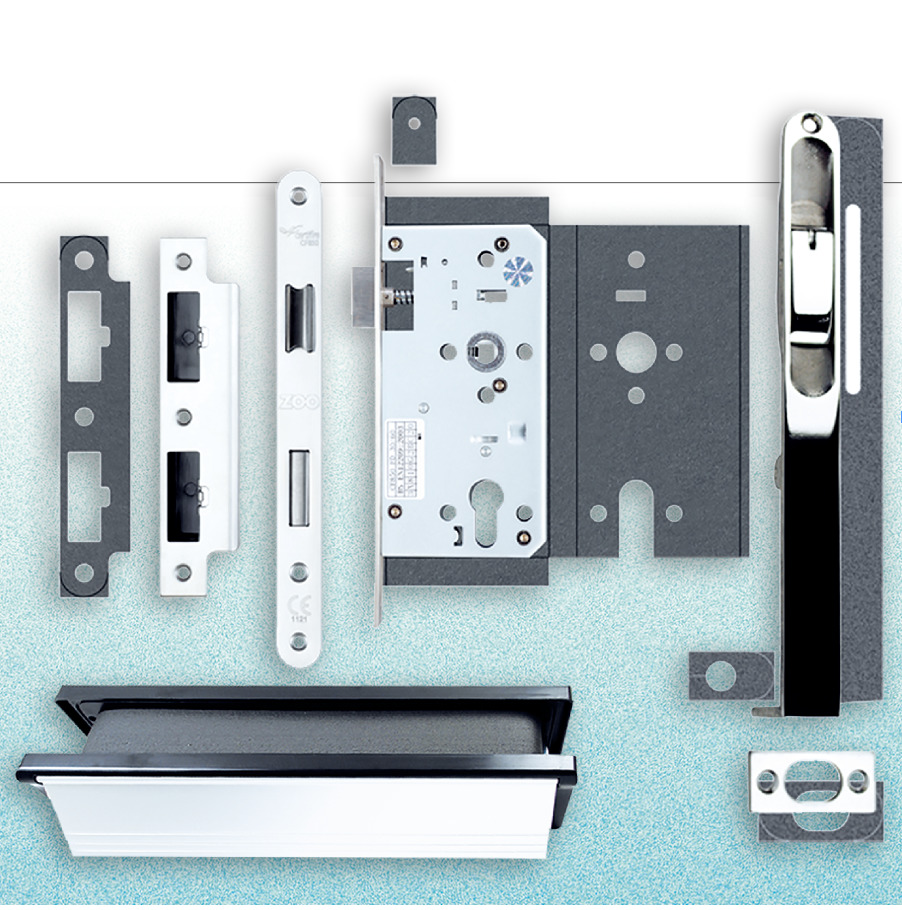
Fire-rated hardware for use in timber doorsets will have been tested to a relevant standard such as BS 476:22 or BS EN 1634:1, in many cases, in conjunction with a custom-made intumescent kit.
To provide a field of application for their products, many hardware manufacturers choose to operate under the Certifire scheme. This was introduced to provide independent third-party certification for fire protection products including fire doors and their associated hardware based on the assessment of relevant test evidence. The certificate also details their intumescent requirements such as material type, thickness, fitment detail, and allows installers to mix and match various items of hardware to meet the desired design criteria.
Hardware that is not covered under a third-party scheme can still be appropriate for use on fire door assemblies. However, the installer must ensure that the fitment detail is the same as tested. To guarantee the correct specification of intumescent, it is advisable to purchase intumescent hardware protection directly from the hardware manufacturer to ensure it complies with existing test evidence.
Be aware
Rebating hardware can drastically affect the integrity of a fire resistant doorset. Fire-rated hardware is only fire-rated when fitted as described in the Certifire certificate or the manufacturer’s test evidence in conjunction with any necessary intumescent protection.
One of the main issues we see with hardware is that it is often advertised as fire-rated or tested to BS 476:22/BS EN 1634:1 but may not immediately detail that it is only fire-rated with the correct intumescent installed. This means, joiners or installers may not understand exactly what is required to be compliant with the test evidence. Always consult the hardware manufacturer if you are not sure what intumescent is needed before fitting hardware to a fire door. It is also always recommended to use a joiner that is FIRAS certified. FIRAS is a voluntary, third-party certification scheme for installation contractors of both passive and active fire protection systems, operated by Warringtonfire and accredited by UKAS to BS EN ISO/IEC 17065:2012.
What standards apply ?
Essential hardware for use in fire-resistant timber doorsets must be CE marked and classified by a European standard. For example, EN 1154 – mechanical door closing devices.
This standard classifies mechanical door closers by using a six-digit coding system. Information included in this classification includes category of use, test cycles, door mass, corrosion resistance, safety, and fire resistance. Closers that are suitable for fire and smoke door assemblies must be subject to satisfactory assessment to either BS 476:22 or BS EN 1634:1.
However, the classification contains no information on how the hardware was tested, what door core was used, how the intumescent was fitted, if any, and what type was used. This is where the issues arise with the classification system. Without the necessary knowledge of fire testing or fire doors, you may assume that because it has been classified as suitable for fire door assemblies, it can be installed on any fire door without further accessories, such as an intumescent kit. This oversight can be devastating to the integrity of the doorset during a real fire.
Get the right product
Not all intumescent materials behave the same. This is especially true for graphite-based intumescent; there is no minimum requirement for graphite content in the material and there is no minimum expansion ratio.
The level of expansion is important as the material must swell sufficiently to fill voids created through rebating for hardware. However, often, the brand of intumescent is not detailed in the test evidence or Certifire certificate and it may simply be referred to as ‘graphite’. This means that it is possible to swap out the intumescent with any brand of intumescent if it is described as graphite-based without any evidence that that brand has been tested with similar hardware on a similar door core and still be compliant with the certification.
Fire doors are not ordinary doors, they are engineered to withstand extremely challenging conditions and each component is integral to their performance. Unfortunately, hardware protection is often overlooked, or cheaper alternatives are substituted which do not perform as well as the intumescent that the hardware was tested with.
Different types of intumescent also have different properties; mono-ammonium phosphate-based (MAP) intumescent reacts at a different temperature to graphite and has a greater level of expansion but expands under no pressure. The insulating properties of MAP are also different to that of graphite, and it is not possible to predict how the rate of heat transfer will alter if these materials are interchanged without empirical evidence.
Fitting a different intumescent than what was tested means that you cannot be certain it will behave the same and the integrity may be drastically affected. Post Grenfell there is an increasing desire for all components to be third party certified as this shows that the manufacturer has gone to great lengths to prove that their products perform as stated and that rigorous quality control measures are met.
Traceability and certification
Unlike intumescent perimeter seals, there is no market requirement for intumescent hardware protection products to be third party certified by a UKAS regulated body, such as Certifire. These products are safety critical in the event of a fire and should, therefore, be subject to the same legal requirements as perimeter seals. However, it is up to the manufacturer to test their products to ensure they are fit for purpose and can provide perfomance evidence.
Third party regulatory bodies and the wider market are wising up to the fact that this may be exploited by companies importing cheaper alternative products without due diligence.
Traceability is a crucial part of third-party certification as it is vital to ensure that any products can be traced back to the manufacturer, when it was made, and the batch of raw materials used.
Using third party accredited hardware protection products removes any ambiguity on whether the material is appropriate for use or has ever been tested to an internationally recognised standard.
Copy by Henry Rowden, technical manager of Vanquish Hardware Protection. Vanquish has produced a CPD on Intumescent Hardware for the GAI.








